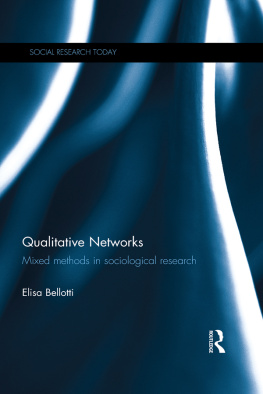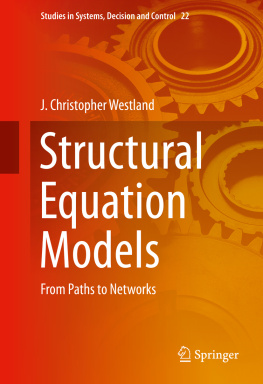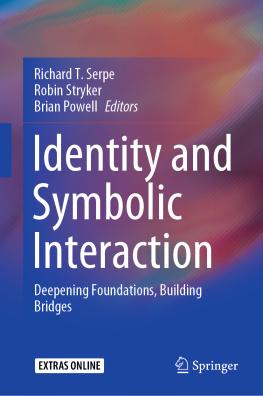First published in 1991
This edition first published in 2015
by Routledge
2 Park Square, Milton Park, Abingdon, Oxon, OX14 4RN
and by Routledge
711 Third Avenue, New York, NY 10017
Routledge is an imprint of the Taylor & Francis Group, an informa business
1991 Ronald L. Breiger
All rights reserved. No part of this book may be reprinted or reproduced or utilised in any form or by any electronic, mechanical, or other means, now known or hereafter invented, including photocopying and recording, or in any information storage or retrieval system, without permission in writing from the publishers.
Trademark notice: Product or corporate names may be trademarks or registered trademarks, and are used only for identification and explanation without intent to infringe.
British Library Cataloguing in Publication Data
A catalogue record for this book is available from the British Library
ISBN: 978-0-415-72731-0 (Set)
eISBN: 978-1-315-76997-4 (Set)
ISBN: 978-1-138-78377-5 (Volume 20)
eISBN: 978-1-315-76548-8 (Volume 20)
Publishers Note
The publisher has gone to great lengths to ensure the quality of this reprint but points out that some imperfections in the original copies may be apparent.
Disclaimer
The publisher has made every effort to trace copyright holders and would welcome correspondence from those they have been unable to trace.
Explorations in Structural Analysis
Dual and Multiple Networks of Social Interaction
Ronald L. Breiger
Copyright 1991 by Ronald L. Breiger.
All rights reserved.
Library of Congress Cataloging-in-Publication Data
Breiger, Ronald L.
Explorations in structural analysis : dual and multiple networks of social interaction / Ronald L. Breiger.
p. cm. (Harvard studies in sociology)
Includes bibliographical references.
ISBN 0-8240-9271-6 (alk. paper)
1. Social interaction. 2. Social networks. 3. SociologyMethodology. I. Title. II. Series.
HM291.B697
302dc20
1991
91-9337
Printed on acid-free, 250-year-life paper
Manufactured in the United States of America
Design by Julie Threlkeld
At a time when most of the innovative techniques in empirical sociology concern themselves with networks of relations among variables (such as indices of occupational prestige, education, and income), the central theme of this volume is that there is much substantive insight and analytical leverage to be gained from a conceptualization of social structure directly, as regularities in the patterning of relations among concrete entities. The view adopted here is that variate distributions measure selected consequences of structural pattern (of the actual connections among individuals or organizations) and, as such, they are useful indicators of questions to be asked in analyzing social structures directly, but they are neither descriptions nor analyses of the structure itself.1
In the three chapters comprising this study, this concern for patterns of social relationships as the fundamental phenomena in need of sociological analysis finds expression in the development and application of network models for analysis of stratification in scientific specialties and community elites, and in the formulation of a distinctive conceptualization of social interaction among units at various levels of social structure (for example, among persons and groups, or among individuals and their attributes).
The first two chapters of this volume are reproduced from my doctoral dissertation (Breiger, 1975). All three chapters have been previously published, in diverse places.2 I am pleased to gather into a single volume these three explorations in structural analysis. All written in the 1970s, they are among the first contributions by one member of a Harvard research group, centered around Harrison White in the 1960s and 1970s, that led to a resurgence of interest in models of social network structure.3
Although network analysis is sometimes characterized as a recent theoretical development (Wallace and Wolf, 1986, pp. 27786), interest in structures of social relationships as providing the foundation for distinctively sociological analysis may be traced to the so-called formal school of classical theorists (e.g., Simmel, 1950; Wiese, 1941).4 In his programmatic statement of 1931, Leopold von Wiese asked his reader to imagine what would be seen if the constantly flowing stream of interhuman activity were halted in its course for just one moment.
We will then see that it is an apparently impenetrable network of lines between men. There is not only a line connecting A with B, and B with C, etc., but C is directly connected with A, and, moreover, A, B, and C are enclosed within a circle. Not only is there one line connecting A with B, and not only one circle in which they are enclosed, but there are many connecting lines.
These connections between A and B, and between A and C, and also between Y and Z, and Y and A, are called a social relationship, and the entire network is called the social system of relations . A static analysis of the sphere of the interhuman will consist in the dismemberment and reconstruction of this system of relations. Outside this network, above and below it, there can be nothing that is social, unless we leave the plane of empirical observation (Wiese, 1941, pp. 2930).
The first chapter of this volume, which explicitly begins with the affiliation metaphor of Simmel, treats the problem of the dual interpenetration of networks at two distinct levels of social structure: networks among persons, and networks among groups. The interrelation of these levels has long been an unresolved issue in network analysis (and in sociological analysis more generally; see, e.g., Alexander, et al., 1987). Lorrain (1973, p. 13), for example, asks:
How do the different kinds of macro- and microstructure present in a social system interact with each other? One thing is certain: no social system, except for rare and very simple ones, is only a network of individual-to-individual relationships. The simultaneous existence of several different levels of structure is one of the fundamental contradictions in social structure.
To what extent does not this set of problems force us to abandon the pure network standpoint in terms of which these problems have [previously] been formulated? Or perhaps these problems can be solved within the pure network standpointat least in part. Indeed, this hope is one of the basic motivations of the network approach to social phenomena.5
two networksone representing ties among persons and one of group-to-group connectionsare both completely specified by a single matrix of person-to-group affiliations (a membership list, so to speak). Suppose, however, that we begin either with ties among persons or with ties among groups, and we seek to specify the dual (respectively: intergroup, interpersonal) network, such that there exists some membership list which implies the original (interpersonal or intergroup) configuration. It may be shown that this translation process between levels does not in general lead to a unique membership list, but to many possible lists. Elsewhere (Breiger, 1990b), I have taken some first steps toward investigation of this translation process. However, a fully adequate solution remains a challenge. Such a solution would provide one way to conceptualize the amount of freedom that a particular configuration of persons allows on the formation of their own groups (and conversely in the dual case: the amount of freedom that a particular configuration of overlapping memberships allows on the ties among members). This is an essentially Simmelian formulation of the problem. In his discussion, Simmel (1950, pp. 12022) conceived of freedom not as an attribute of an individual but as a property of a configuration of persons; freedom is therefore a topic of sociological inquiry.









